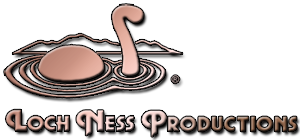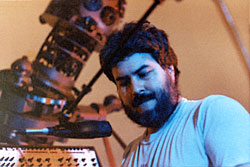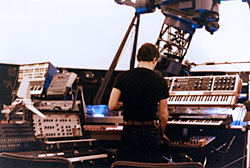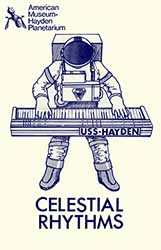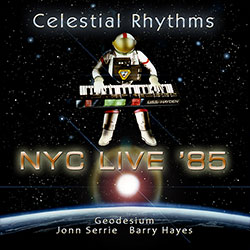
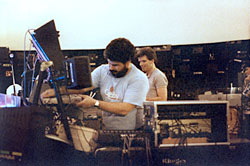
Mark and Jonn set up their gear
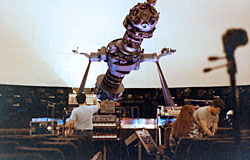
Another angle (Annie Serrie looks on)
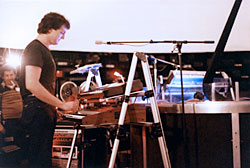
Barry sets up (Joe Doty looks on)
Celestial Rhythms: NYC Live '85
A rare release from a rare group!
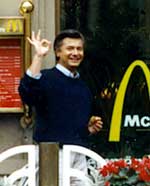 When I became Chairman of the American Museum-Hayden Planetarium in 1982, I followed in the tradition set during my formative years at the Strasenburgh Planetarium in Rochester, New York — namely utilizing the magical space of the planetarium theater for a wide variety of programs related to both science and the arts.
When I became Chairman of the American Museum-Hayden Planetarium in 1982, I followed in the tradition set during my formative years at the Strasenburgh Planetarium in Rochester, New York — namely utilizing the magical space of the planetarium theater for a wide variety of programs related to both science and the arts.
Over the years, this included astronomy-oriented shows narrated by Hollywood's Golden Age greats such as Gregory Peck and Burt Lancaster, as well as many Star Trek cast members. I partnered with the Children's Television Workshop to create a show called Wonderful Sky for preschoolers with the Sesame Street Muppets. With Lucasfilm, we shot those loveable droids R2D2 and C-3P0 of Star Wars fame at Industrial Light & Magic and turned them into the co-hosts of another children's show, Robots in Space.
The planetarium theater in New York became a concert space featuring jazz greats who had played with Billie Holiday. Christmas and Valentine's Day concerts performed by the award-winning Ensemble for Early Music featured visuals created in conjunction with the Vatican, the Musée Condé north of Paris, and the New York Metropolitan Museum of Art; using both sight and sound, it took audiences through the royal courts of the European Renaissance.
Against this backdrop, I decided to create a concert in which the three most famous space music composers of the day would perform. And so, Mark Petersen, Jonn Serrie and Barry Hayes made their way to the Big Apple to play their first joint concert. For your listening pleasure, here are some wonderful moments from that very special night under the planetarium's starry dome 30 years ago. Enjoy!
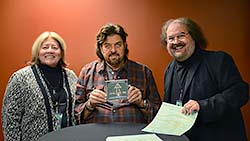 35 years later, I finally was able to tell my story about performing I Robot for Isaac Asimov — to Alan Parsons himself!
35 years later, I finally was able to tell my story about performing I Robot for Isaac Asimov — to Alan Parsons himself!
In 2020, we met up with him before a concert in Denver. I asked Alan if he had ever met or talked with Asimov; he replied "Eric (Woolfson) did." I told him how I'd recorded his piece as an encore, and made a verbal dedication to Asimov during that night's performance.
I presented Alan with a CD of this album. He graciously asked me to autograph it for him, which I was honored to do.
And of course, "Pics or it didn't happen...", so here's the proof, with Carolyn as my witness!
Celestial Rhythms: NYC Live '85 takes listeners back to an innocent time, when planetarium theaters were inspirational, special places that took audiences to the stars, with audio-visual experiences scored by composers who created the genre that became known as "space music".
In 1983, Bill Gutsch, director of the Hayden Planetarium of the American Museum of Natural History in New York City, invited three of the planetarium world's noted musicians to perform live in a concert setting for the public and a regional convention of planetarium professionals. In Colorado, Mark C. Petersen had been recording planetarium soundtracks for a decade, had previously released two Geodesium albums, and formed Loch Ness Productions to market his growing library of music to planetaria worldwide. Jonn Serrie, in Atlanta, Georgia, had already worked with Bill to record soundtracks for several Hayden Planetarium shows. Barry Hayes was the Audio Technician and composer on the staff of the Science Museum of Virginia's Universe Planetarium in Richmond. It took over a year to work out the details, but eventually dates were set, and planning got underway.
Preparing in their studios beforehand, each musician took primary responsibility for arranging and recording tracks for certain selections to be performed as a trio. And, each readied one special number to shine as a spotlighted solo feature. They exchanged cassette mixes and music by mail in the weeks preceding the concert so they could work up the parts they would eventually play live.
Because the group was heretofore an "unknown quantity" to the general public, the Hayden staff requested the concert include some specific recognizable popular selections, in addition to each musician's original compositions. Mark brought two classical transcriptions to the playbill; it took little prompting for Jonn to provide his fighter-jet-pilot-themed movie and TV soundtrack fantasy; and Barry answered the "Give us Star Wars music" challenge. These were what got promoted on the poster Hayden staff artist Brian Sullivan created for the event.
When the time came to perform the concerts, the three musicians loaded up their cars with their drum machines, synthesizers, tape decks, outboard equipment and spouses, then hit the highways bound for New York City. They gave two sold-out performances at the Hayden Planetarium, preceded by one at the Ocean County College Planetarium in Toms River, New Jersey.
The musicians each had their own station of gear — a rack or two of keyboards and synth modules apiece, along with outboard signal processors, and supplemental and backup parts pre-recorded on tape. All these were fed into their own individual mixers. The stereo audio feeds from each mixer were then cabled to a second mixer, which fed a combined stereo mix to the planetarium's theater sound system. The musicians were responsible for maintaining the proper levels and mixing; there was no audio engineer overseeing things.
The concert recording itself was initially unplanned. Only at the last minute did one of Jonn's friends insert a cassette recorder into the chain — unbeknownst to anyone. Jonn was greatly alarmed when he found out, just before going onstage. He feared the audio sends might have gotten bollixed up in the process, potentially ruining the concert. Fortunately, there were no problems, and the recording came out fine.
Ordinarily, a "board mix" made in this manner would sound quite "dry", without reverb. But each musician had a microphone at his stage position, also fed into their mixers. Apparently at least some of these mics were left open continuously during the performance, and they fortuitously provided a chance for room ambience to be captured in the recording. There were over 500 people in the sold-out theater, but on the recording the audience's response seems quite subdued. This is simply because it comes only from the sound leaking into the mix from the musician's inadvertently open microphones, and only the sound of people cheering nearby was picked up. In reality, the applause was often extremely enthusiastic.
The original stereo cassette recording was transferred to reel-to-reel tape in 1985 for safekeeping. To make this album, that tape was first baked, so it could then be played and digitized. The between-selection introductions, dedications, joking and other patter from the musicians were excised, levels normalized and EQ applied. Editing and mastering was done by Mark, using Sony Vegas Pro.
Photos by Carolyn Collins Petersen
Select a title to hear a 30-second MP3 clip
1. Celestial Rhythms was the concert opener Jonn brought.
2. Kanon in D was a particular favorite of Hayden staffer Allen Seltzer. Mark obliged with a uniquely arranged rendition, and took the lead canon voice; Barry and Jonn followed with the second and third canon parts. The story behind the creation of this track is detailed in the notes for Geodesium Arcturian Archives.
3. Tumble Run was introduced by Jonn as a bit of what he called "technological terrorism for all you syncopation people."
4. The planetarium had a chance to run through its gamut of visuals to provide a solar system tour to accompany the group as they performed Mark's Voyager (from Geodesium Double Eclipse).
5. Universe Themes provided Barry with his time to shine, as he performed solo five selections he'd created for the shows at the Universe Space Theater of the Science Museum of Virginia in Richmond, where he was the planetarium audio technician and composer.
6. The story behind the creation of Repighi's Pines of the Appian Way is detailed in the notes for Geodesium Arcturian Archives. It comprises 107 tracks of mostly Prophet-5 synthesizer that were used to create this arrangement. For his solo feature in the concert, Mark took the part of the percussionist in the "orchestra", and performed live on the Emulator II the timpani, triangle, cymbals, and tam-tam (gong) parts, playing along with his pre-recorded tape accompaniment.
7. Jonn dedicated his solo performance of Where Lovers Walk to his wife Annie, who was in the audience.
8. Barry created the arrangement of John Williams's Yoda's Theme from The Empire Strikes Back.
9. Zephyr would eventually be featured on the album Geodesium West of the Galaxy. Rob Sparkes, Hayden's laserist, outdid himself with the visuals, choreographing to the music a myriad of moving diffraction dots on the dome.
10. The prototype And With You 2 didn't have a name at the time of the 1985 concert; its eventual release on Jonn's first album And The Stars Go With You was still several years in the future.
11. Barry said Star Shadows was composed for the solar eclipse of the previous year; its path of annularity had crossed right over his home in Virginia.
13. Jonn always had a fascination with jet planes and fighter pilots; he had even set up little aircraft models around his keyboard station for the concert. His medley of the movie and TV show themes The Right Stuff / Call to Glory provided an energetic concert closer.
14. The famous science fiction author Dr. Isaac Asimov was a friend of the Hayden Planetarium. The group had been informed the Good Doctor would be in the audience that night. So Mark thought it would be the perfect choice to arrange for the group their own version of the Alan Parsons Project's I Robot as an encore.
|
|
|
